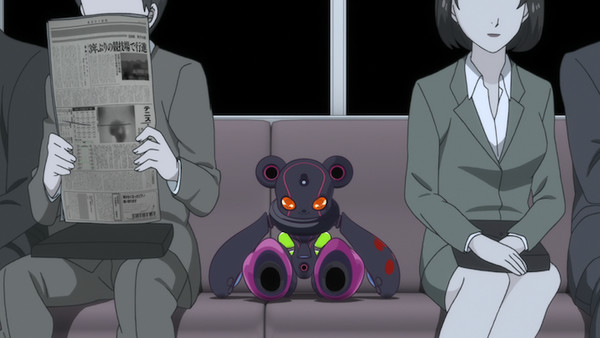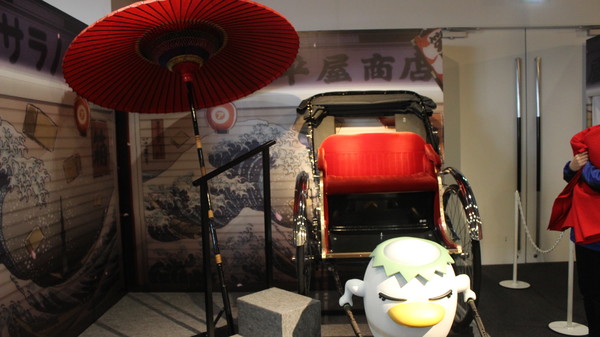Interest
Utena, Sarazanmai Director Ikuhara's Exhibit Reveals His Works in Its Earliest Forms
posted on by Kim Morrissy
 The works of acclaimed anime director Kunihiko Ikuhara took center stage from April 27 to May 9 at the "Kunihiko Ikuhara Exhibition: The Desire to Connect Us and The Survival Strategy of the Revolution." Not only does it focus on Ikuhara's original anime, including Revolutionary Girl Utena, Penguindrum, Yuri Kuma Arashi, and Sarazanmai, the exhibition also includes information about Ikuhara's non-animation projects and his creative process in general. Rough notes, character drafts, and pitch documents were on display, showing Ikuhara's works in their earliest forms.
The works of acclaimed anime director Kunihiko Ikuhara took center stage from April 27 to May 9 at the "Kunihiko Ikuhara Exhibition: The Desire to Connect Us and The Survival Strategy of the Revolution." Not only does it focus on Ikuhara's original anime, including Revolutionary Girl Utena, Penguindrum, Yuri Kuma Arashi, and Sarazanmai, the exhibition also includes information about Ikuhara's non-animation projects and his creative process in general. Rough notes, character drafts, and pitch documents were on display, showing Ikuhara's works in their earliest forms.
(Note: Photos were prohibited throughout most of the exhibit, so I've done my best to describe what I saw as thoroughly as I can.)
First, a brief rundown of Ikuhara's life and career: he was born in 1964 and was artistically inclined from childhood. Throughout high school and university, he drew manga and created live-action films. After graduating from the Kyoto College of Art, he joined Toei Animation (then Toei Doga) in 1986 as a trainee. He started his career as a production assistant on Maple Town. Even as a fresh recruit, he was pitching original anime ideas, although none of them came to fruition at the time. Writing pitches gave him motivation, however, and according to the exhibit text, at least one of his ideas from this time was connected to Keppi from Sarazanmai.
In 1990, Ikuhara made his directorial debut on episode 18 of Mōretsu Atarō. From there, he started directing episodes of various series at Toei, and in 1993 he became the series director of Sailor Moon for Sailor Moon R, S, and SuperS. This would be the big break in his career, and in 1994 he started working in earnest on his pitch for Revolutionary Girl Utena.
In May 1995, Ikuhara's collaborator Chiho Saitō, who drew the manga version and original character designs for Revolutionary Girl Utena, exchanged designs with Ikuhara over fax. From the early illustrations, it's evident that the characters underwent some significant transformations before they arrived at their finished form. For example, Utena's first design showed her wearing a long gakuran (Japanese male school uniform jacket) and long pants, but Ikuhara told her that he would prefer both of these to be shorter. He drew her a rough sketch of what he wanted, and Saito quickly revised her design into the more familiar one seen in the anime.
The plot also underwent some changes. The original pitch was about a group of female warriors called the "Neo Elegansar" who fight against "The end of the world." The concept seems very influenced by Sailor Moon, although all the girls dress up in men's clothes. The protagonist Utena transforms through kissing. Hence, the original title was pretty straightforward: "Revolutionary Girl Utena Kiss."
In 1996, Ikuhara left Toei and created the Be-PaPas creative group, which consisted of him, Chiho Saitō, writer Yōji Enokido, animator and character designer Shinya Hasegawa, and producer Yūichirō Oguro. After Revolutionary Girl Utena aired in 1997, Ikuhara stopped directing anime until 2011, when Penguindrum came out. Ikuhara moved to Los Angeles for a year in 2001, but he was back to pitching original anime after he returned to Japan.

Around 2005-2006, he was working on a pitch for an animated film for Nokemono to Hanayome (The Nokemono & The Bride). This would be based on a "gothic lolita hard battle" novel Ikuhara wrote with the same title, which was serialized in the teen fashion magazine Kera. This was followed up with a manga sequel in 2007, which was drawn by Asumiko Nakamura (the woman who would later go on to draw the acclaimed BL manga Doukyusei -Classmates-). The proposed anime would be called Nokemono to Hanayome+ (pronounced "cross"), and although the anime didn't happen, the story did come out in manga form in 2018.
Nokemono to Hanayome was actually quite a formative work that would go on to inform Ikuhara's later projects. The manga centers on the "cruel and dangerous" love between the girl Hitsuji Sera and the boy Itaru Hagumazuka, who wears a bear costume. This has obvious parallels to Yuri Kuma Arashi, minus the yuri. The story was also inspired by the Tokyo subway sarin attack of 1995, much like Penguindrum.
Speaking of Penguindrum, it took multiple pitches before the story as we know it took form. Ikuhara first partnered up with Penguindrum original character designer Lily Hoshino to work on a pitch in 2008 for an anime called Yakusoku no Orakorona. The story was about two parallel worlds that are linked together, and the things that happen in one world are reflected in the other. This plot appears to have been shelved completely, but Ikuhara did keep Hoshino as the character designer when they worked on another pitch together in 2009, this one closer to Penguindrum.
Called Mezame yo! Iris Drum (Awaken! Iris Drum), this pitch was a true proto-Penguindrum. The character designs for Kanba, Shōma, and Himari are the same as they are in Penguindrum, although the plot was markedly different. For one thing, the two brothers are from an alien planet who are out to destroy Earth because they think it's the only way to save their home planet. Also, the girl who looks like Himari isn't their sister, and the character who takes on the "youngest sibling" role is actually a cat-eared boy named Hinata.
Overall, it's quite a different story, although some of the elements of that earlier story still remain in the final anime. For example, take the mechanical bears which appear in the Crystal World where the "Survival Strategy" segments take place. These were first drawn for Mezame yo! Iris Drum, and were probably mechas that were piloted by people from Kanba and Shōma's planet. Shōma is also shown wearing a skin-tight pilot suit, implying that he would have been piloting these robot bears. In Penguindrum, the bears ultimately serve a different (yet perhaps equally important) purpose.


It wasn't long before the final pitch for Penguindrum was completed; it was also done in 2009. Notably, this is the first time the penguins even show up, but they're all over the place now.
By contrast, the original pitch for Yuri Kuma Arashi was fairly close to the final anime. The early sketches by Akiko Morishima showed some slightly different-looking designs for the main characters, but the main motifs like the bears and the Severance Court are also present from the beginning. One thing to note in particular is that Ikuhara wanted the bears to be creepy rather than simply just cute. This was why he initially drew them with blank eyes and jagged teeth, and this design is closely maintained by both Morishima and the anime's chief animation director Etsuko Sumimoto.
Then there's Sarazanmai. As was also mentioned in the anime's official guidebook released last month, the idea for the anime started with the kappas. Even before the human versions of the main characters were realized, Ikuhara was sketching what they looked like as kappas. The early sketches also show the otter mark and a shirikodama being extracted from Kazuki's bottom. The official pitch documents weren't shown at the exhibit, but according to Ikuhara, certain details were deliberately left out.
Besides rough notes and sketches, the exhibit also showed off screenshots and finished designs from each anime, along with notes by Ikuhara where he shares some of his thoughts on the themes. For example, with Revolutionary Girl Utena, he said he was going for a story where "princesses are cool the way they are." Penguindrum is a story about deciding your own fate and challenging preconceived notions about what the family unit should be like, while Yuri Kuma Arashi is Ikuhara's idea of a romantic story where a girl who keeps insisting that she'll save the other person ends up being the one saved in the end. Sarazanmai is a story about the struggle for human connection in an era where everyone is digitally connected.
Note that I'm paraphrasing his statements a lot, and there's no clear cut way that you're supposed to interpret things. In the end, you just have to watch all of his anime and think about which parts spoke to you.

One other thing I want to highlight: near the end of the exhibit there's a recreation of Keppi pulling a rickshaw. The staff offer to take photos of visitors sitting in the rickshaw. This was a pretty cool idea for a photo spot, although I do feel a little sorry for Keppi pulling along a rickshaw throughout the entirety of Golden Week.